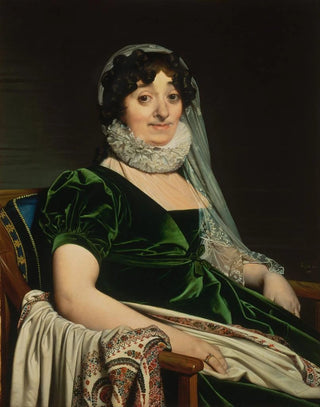Art print | Portrait of Countess of Tournon - Jean-Auguste-Dominique Ingres


View from behind

Frame (optional)
In the world of art, some works transcend time and culture, captivating the mind and imagination of viewers. "Portrait of the Countess of Tournon" by Jean Auguste Dominique Ingres is one of those creations that, through its elegance and depth, continues to spark the interest of art enthusiasts. This painting, created in the early 19th century, offers a fascinating glimpse into French high society, while revealing the unparalleled talent of its creator. The depiction of the countess, both majestic and intimate, embodies a perfect fusion of academic technique and emotion, immersing the viewer in a universe where beauty and refinement reign supreme.
Style and uniqueness of the work
Ingres's style is distinguished by its precision and attention to detail. In "Portrait of the Countess of Tournon," every element is carefully rendered, from the drapery of the dress to the delicate features of the face. The color palette chosen by the artist evokes an atmosphere that is both gentle and vibrant, where shades of blue and pink blend harmoniously. This portrait is not limited to a simple representation; it captures the very essence of its subject's personality. The countess's eyes, filled with a certain melancholy, seem to tell a story, while her elegant and confident posture reflects her social status. Ingres manages to balance academic rigor with artistic sensitivity, creating a work that transcends the conventions of its time.
The artist and his influence
Jean Auguste Dominique Ingres, an emblematic figure of Neoclassicism, made his mark through an innovative approach to painting. Trained under the guidance of Jacques-Louis David, he quickly established himself as a master of portraiture and historical representation. His style, rooted in tradition, was enriched with a personal sensitivity that is uniquely his own. Ingres was able to break free from the rigid norms of his era, incorporating romantic elements and expressive qualities that give his work a timeless modernity. His influence still endures today, inspiring many artists and art lovers around the world.

Matte finish

View from behind

Frame (optional)
In the world of art, some works transcend time and culture, captivating the mind and imagination of viewers. "Portrait of the Countess of Tournon" by Jean Auguste Dominique Ingres is one of those creations that, through its elegance and depth, continues to spark the interest of art enthusiasts. This painting, created in the early 19th century, offers a fascinating glimpse into French high society, while revealing the unparalleled talent of its creator. The depiction of the countess, both majestic and intimate, embodies a perfect fusion of academic technique and emotion, immersing the viewer in a universe where beauty and refinement reign supreme.
Style and uniqueness of the work
Ingres's style is distinguished by its precision and attention to detail. In "Portrait of the Countess of Tournon," every element is carefully rendered, from the drapery of the dress to the delicate features of the face. The color palette chosen by the artist evokes an atmosphere that is both gentle and vibrant, where shades of blue and pink blend harmoniously. This portrait is not limited to a simple representation; it captures the very essence of its subject's personality. The countess's eyes, filled with a certain melancholy, seem to tell a story, while her elegant and confident posture reflects her social status. Ingres manages to balance academic rigor with artistic sensitivity, creating a work that transcends the conventions of its time.
The artist and his influence
Jean Auguste Dominique Ingres, an emblematic figure of Neoclassicism, made his mark through an innovative approach to painting. Trained under the guidance of Jacques-Louis David, he quickly established himself as a master of portraiture and historical representation. His style, rooted in tradition, was enriched with a personal sensitivity that is uniquely his own. Ingres was able to break free from the rigid norms of his era, incorporating romantic elements and expressive qualities that give his work a timeless modernity. His influence still endures today, inspiring many artists and art lovers around the world.






